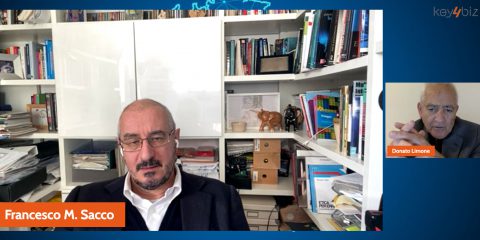Stati Uniti

Reti di Nuova Generazione e competizione, un argomento caldo su cui si confrontano le economie dei paesi e le strategie degli operatori di telecomunicazioni, assieme agli indotti industriali che ruotano intorno ad essi. Un problema strategico per il ruolo dell’ICT nel rilancio della crescita e per le implicazioni occupazionali che ad esso sono collegate. Un’area quindi complessa, quanto determinante, per assicurare la realizzazione di quell’Agenda Digitale alla cui compiutezza sono legate le aspirazioni di rilancio competitivo dell’Europa nel nuovo scacchiere internazionale e nel bel mezzo di una crisi che riformulerà i ranking mondiali.
Di questo abbiamo parlato con Robert Madelin, Direttore Generale della Società dell’Informazione e dei Media presso la Commissione Europea.
Attento osservatore del settore, 54 anni, in Commissione da quasi due decenni, cultura da civil servant, Madelin ha risposto con precisione alle nostre domande. Ecco cosa ci ha risposto.
Key4biz. For the telecom industry the investment capacity is at risk: competition is bringing prices down and new services require more and more bandwidth; margins are eroding and the need for investing in network upgrade is more and more pressing to grant consumers with new services. What is the Commission’s vision on creating the right conditions for the European industry to keep investing?
Madelin. With the Digital Agenda, the Commission has clearly raised the profile and awareness of the need to invest in broadband. It the EU rules and regulations in the field, the Commission aims, and will continue, to set the balance between the right incentives for investment while ensuring that incumbents do not abuse their partly dominant positions
In parallel, the Commission is currently reviewing the State aid Broadband Guidelines, also in order to better take into account the deployment of super-fast broadband. Those guidelines define the conditions when Member States’ financial intervention is justified due to market failures, and when subsidies would do more harm than good. By preventing State aid for measures in which private investors would simply be crowded out, the Commission helps to ensure that public money is spent efficiently and in line with internal market objectives. At the same time, the Guidelines spell out the conditions for when and how governments can support investments of private investors.
So the telecom industry benefits twice. It can be sure that its existing and planned market- based investments are not crowded out by government investments. Secondly, the telecom industry might receive financial support for investments which are not profitable without aid due to market failures.
Key4biz. We are clearly going towards a process of worldwide consolidation in all industries and Europe has to play a role in order not to lag behind other regions of the world in terms of value of the ICT sector. What is your view on the possibility that the paradigm of regulation put in place for copper network may be extended over next generation networks? Could this imply a limitation of operators’ willingness to face risks investments because wholesale regulation limits their perspective of returns for risky investment?
Madelin. Unlike other sectors, the ICT sector has been characterised by a very rapid pace of technological change and a very high degree of innovation. Both of these factors create constant challenges for the leading market players.
The shift from copper networks to next generation access networks should not be the occasion for regulatory holidays. This risks leading us back to the national monopolies which we fought in the 1990s. In fact, Europe needs to create the market conditions which are favourable for investment in broadband structure while at the same time preserving competition with which can encourage innovation and to stimulate demand.
This is precisely what the Commission aims to achieve, in coordination with national telecoms regulatory authorities, through the regulatory approach outlined in our Recommendation on regulated access to next generation access networks (NGAs). In this, the Commission recommended that national telecoms regulations when imposing access obligations on telecoms companies should take properly into account any investment risk occurred, by means of a risk premium in order to allow investors a reasonable rate of return on their investments.
At the same time, the Recommendation aims to help alternative operators to enter and compete in the market, allowing them to climb the ‘ladder of investment’ and gradually to deploy their own network infrastructure.
Key4biz. Next generation networks are at the beginning. Should National Regulators concentrate on regional circumstances (i.e. the degree of competition at local level), as provided also in NGN recommendation, in order to facilitate more relaxed regulatory intervention in specific cases, thus allowing for a boost of investments in areas where network competition is advanced and demand for advanced services more developed?
Madelin. First off, let me underline that regulation is not an obstacle to investment. Nor is relaxing regulation in certain areas a prerequisite to triggering investment. On the contrary, one of the aims of the EU’s rules in this area is to promote efficient investment and innovation in new and enhanced infrastructures.
The NGA Recommendation stresses that the transition from copper-based to fibre-based networks may alter the conditions of competition in different geographic areas since patterns of deployment may vary significantly between areas and Member States.
When substantial and objective differences of competition exist, telecoms regulators can vary the remedies they apply to each geographic area. Where these differences are stable over time, regulators should differentiate regulation, including lifting ex-ante remedies, according to geographic markets.
In this way, telecoms regulators are encouraged to examine whether regional differences in conditions of competition arise during the roll-out of NGAs and have the option to vary remedies accordingly.
The practice of the national telecoms regulators shows that, to date, the wholesale broadband access market or bitstream access is more and more competitive, particularly in urban areas. However there continue to be competitive bottlenecks across national territories in the wholesale physical market.
This is why the Commission has endorsed a more light-touch regulation and even a complete lifting of remedies in some geographic areas in the bitstream markets (like in the UK, Poland, Romania and in the Czech Republic).
The lifting of all remedies, including fibre unbundling, is, however, challenging given that, in line with the NGA Recommendation, telecoms regulators have to demonstrate that the presence of several alternative infrastructures, such as Fibre to the home, and/or cable in combination with competitive access offers is likely to result in effective competition at retail level
Here the Commission has been very cautious in relation to accepting a complete de-regulation in a specific area in the absence of strong evidence that competition will not be hurt.
Key4biz. Let me now consider the public/private partnerships or agreements between private companies and regional authorities to develop next generation networks that are emerging throughout Europe. We have the called “Trento case”, in Italy, where the Province and private operators have put together a model for the development of high speed networks. Does the Commission support such best practices, where the willingness of public administration and of private companies, will accelerate investments in new networks? Do you think such models should be supported at EU level?
Madelin. Firstly, let me say that public intervention is important, in particular to support high speed deployment in underserved areas. At the same time it is important to limit distortions of competition and trade inside the EU and avoid crowding out private investments.
The Commission is convinced that there is a particular case for public private partnerships, namely in the areas where there is no immediate business case for private sector.
At the end of June the Commission presented its proposal for a multi-annual EU budget for 2014-2020. In this, we outlined our plans for a Connecting Europe Facility, which could provide substantial financial support in the form of credit enhancement or grants to “riskier” projects investing in high-speed broadband infrastructure. This could, among others, provide support to public private partnerships, where for example public parties invest in passive infrastructure and stimulate the take up via demand aggregation, while the private parties concentrate on investing in active elements of the network.
The Commission has already launched a study which aims to look at various successful models of PPP cooperation. By the end of the year we’ll issue guidelines for investment for public authorities focusing on best practice. The European Broadband Portal has also carried out a similar exercise, based on outcomes of discussions at our Digital Agenda Assembly, which aim to identify investment blueprints for public authorities.












